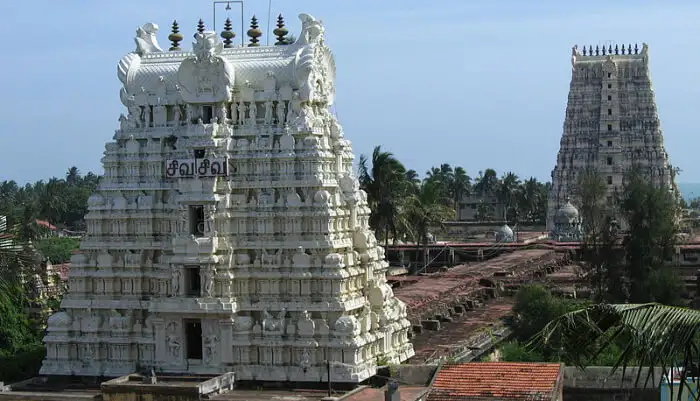



Blogs Top 5 Temples in Rameswaram: Which Ones Should You Visit?

Rameswaram is renowned for its spiritual heritage and temples. Here are five famous temples in and around Rameswaram:
Significance: The most famous temple in Rameswaram, dedicated to Lord Shiva. It is one of the 12 Jyotirlinga temples in India. The temple is known for its longest temple corridor in the world, with intricately carved pillars.
Key Attraction: The 22 sacred wells or "Theerthams," where devotees take ritual baths.
The Ramanathaswamy Temple is one of the 12 Jyotirlinga shrines dedicated to Lord Shiva, making it one of the most revered temples for Shaivites (followers of Shiva) in India.
The temple is famous for having the longest corridor among all Hindu temples in the world, spanning approximately 1,200 meters. The corridors are adorned with 1,212 intricately carved pillars, showcasing Dravidian architectural excellence.
According to Hindu mythology, Lord Rama, after defeating Ravana, worshipped Lord Shiva here to absolve his sins. The lingam in the temple is said to have been installed by Lord Rama himself.
The temple features 22 sacred wells, or "Theerthams," within its premises. Devotees believe that bathing in these wells purifies the soul, and each well's water is said to have different medicinal and spiritual properties.
The temple is a crucial stop in the Char Dham Yatra, a pilgrimage circuit that includes Badrinath, Dwarka, Puri, and Rameswaram. It is considered one of the holiest places for Hindus across India.
Significance: This ancient temple is located near Dhanushkodi and is dedicated to Lord Rama. It is believed to be the site where Lord Rama crowned Vibhishana, the brother of Ravana, as the king of Lanka.
Key Attraction: Its coastal location and serene environment, with mythological and historical significance.
The Kothandaramaswamy Temple is believed to be the site where Lord Rama performed the coronation ("Pattabhishekam") of Vibhishana, the brother of Ravana, after he surrendered to Rama during the Ramayana epic.
The temple is located near Dhanushkodi, on a serene coastal strip, surrounded by the sea on three sides. Its scenic and isolated location adds to the spiritual atmosphere, making it a peaceful pilgrimage spot.
While most of Dhanushkodi was destroyed by a devastating cyclone in 1964, the Kothandaramaswamy Temple miraculously survived and still stands as a testament to its resilience and divine significance.
The temple is dedicated to Lord Rama and houses idols of Rama, Sita, Lakshmana, Hanuman, and Vibhishana, symbolizing the events of the Ramayana.
This temple is a key stop for pilgrims visiting Rameswaram, as it holds a sacred connection to the Ramayana. Devotees come here to honor Lord Rama's compassion and his acceptance of Vibhishana.
Significance: Dedicated to Lord Hanuman, this temple is famous for its idol depicting Hanuman with five faces, and it holds an important place in the Ramayana legend.
Key Attraction: The floating stones on display that are believed to have been used to build the Rama Setu bridge.
The temple is renowned for its idol of Lord Hanuman with five faces (Pancha Mukha Hanuman). The faces represent Hanuman, Narasimha, Garuda, Varaha, and Hayagriva, each symbolizing different powers and attributes.
The temple holds significant importance in the Ramayana epic. It is believed that this is where Hanuman revealed his five-faced form to extinguish five lamps simultaneously to kill the demon Ahiravana and rescue Lord Rama and Lakshmana.
One of the unique attractions of the temple is the display of "floating stones" that are believed to have been used in building the Rama Setu (Adam’s Bridge), the bridge that Lord Rama and his army used to reach Lanka.
The temple is a vital pilgrimage site for devotees of Lord Hanuman, as it is believed that worshipping here brings strength, protection, and blessings. Many devotees also tie sacred threads around the temple as part of their prayers.
Located close to the Ramanathaswamy Temple, this temple is often visited by pilgrims as part of their spiritual journey in Rameswaram, making it a key stop for those seeking blessings from both Lord Hanuman and Lord Rama.
Significance: A historic temple located 8 km from Rameswaram, it is dedicated to Lord Rama. This temple is considered a powerful site for devotees to pray for rain and well-being.
Key Attraction: Its peaceful ambiance and historical connection to the Ramayana.
The Nambu Nayagiamman Temple is dedicated to Lord Rama and is revered by devotees who believe in the temple's power to fulfill prayers, especially for rain and prosperity.
The temple is believed to be several centuries old and has strong roots in local beliefs and traditions. It is said that the temple was built by the people of Ramnad who prayed to Lord Rama for rain and good harvests.
The temple is located about 8 km from Rameswaram, nestled in a serene, picturesque setting surrounded by greenery, making it a peaceful spot for devotees and visitors seeking spiritual solace.
Devotees hold a strong belief that praying at the Nambu Nayagiamman Temple brings miracles, especially concerning health, rainfall, and family well-being. It is a place where locals gather during times of drought to perform rituals.
Unlike the grand temples of Rameswaram, Nambu Nayagiamman Temple has a modest structure, but its simplicity is what adds to its sacredness. The temple has a quiet, spiritual charm that attracts both locals and tourists looking for a peaceful worship experience.
Significance: Located close to Rameswaram, this temple is believed to be the place where Lord Rama washed his hair (Jada) before worshipping Lord Shiva. It is a small yet sacred temple.
Key Attraction: The temple’s spiritual importance and serene setting surrounded by trees and a pond.
Jada Tirtham is believed to be the site where Lord Rama washed his "Jata" (matted hair) before worshipping Lord Shiva at the Ramanathaswamy Temple. This act of purification is of great spiritual importance in the Ramayana epic.
The tirtham (holy water) at Jada Tirtham is considered highly sacred by pilgrims. Many devotees take a ritual bath here before proceeding to the main temple in Rameswaram, believing the water has purifying properties.
A small temple dedicated to Lord Shiva is located near the water body at Jada Tirtham. Despite its modest size, the temple holds significant spiritual value and offers a peaceful environment for meditation and worship.
According to local legend, Jada Tirtham is also the place where Lord Shiva’s divine bull, Nandi, is said to have rested. There is a sacred shrine dedicated to Nandi here, which adds to the site's religious significance.
Jada Tirtham is surrounded by lush trees and natural beauty, providing a tranquil setting for pilgrims. Its serene environment offers a quiet, reflective space for devotees away from the more crowded areas of Rameswaram.
These temples not only offer religious significance but also provide an insight into the architectural grandeur and cultural history of Rameswaram.